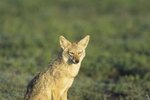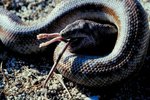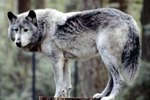The bobcat is North America's most widespread wild cat species. They are found as far north as southern Canada and as far south as northern Mexico. Typically, an adult bobcat is twice as big as a normal house cat and is a formidable predator for its size. Even so, the bobcat has enemies that are more than capable of killing and eating them.
Mountain Lion
Standing about twice the height and weighing over 100 lbs. more than bobcats, their distant cousin the mountain lion is among their main predators. Less widespread than the smaller bobcat, the two species still share much of the same range. The mountain lion both stalks and ambushes its prey, often dispatching the animals with a bite to the back of the neck, breaking it and causing paralysis if not instant death. Although a mountain lion would likely prefer prey such as deer, bighorn sheep or small rodents, a chance encounter with a bobcat offers a potential meal.
Wolves
Sharing part of the bobcat's northern range, gray wolves are both a competitor and a predator of the cat. Wolves are much larger, outweighing the small cats by well over 100 lbs. and measuring almost twice the length. Wolves generally hunt in packs, so most any animal is a possible meal to a hungry wolf. The preferred prey of wolves consists of large mammals such as deer as well as smaller animals such as rodents, reptiles, birds and fish.
Coyote
A smaller cousin of the wolf, coyotes are a little larger than bobcats. On average, a coyote is 20 lbs. heavier, a few inches taller and several inches longer. It is unlikely for a coyote to be able to hunt an adult bobcat as it would be risking a lot of harm to itself. Bobcat kittens left alone, however, are at risk from the coyote which will take almost any potential food. Coyotes are widespread throughout the U.S. and will often share the same habitat as bobcats.
Golden Eagle
Growing to 3 feet in length and reaching around 15 lbs., a golden eagle might itself be at risk from an adult bobcat. Injured or unsuspecting birds on the ground could fall prey to a stalking cat. The eagle, however, although it is not large enough to try and take an adult, has been known to take domestic cats and would certainly swoop and take a small bobcat kitten if given the chance. The preferred prey of eagles includes small ground mammals, birds and reptiles.
References
Photo Credits
-
Jupiterimages/Photos.com/Getty Images





